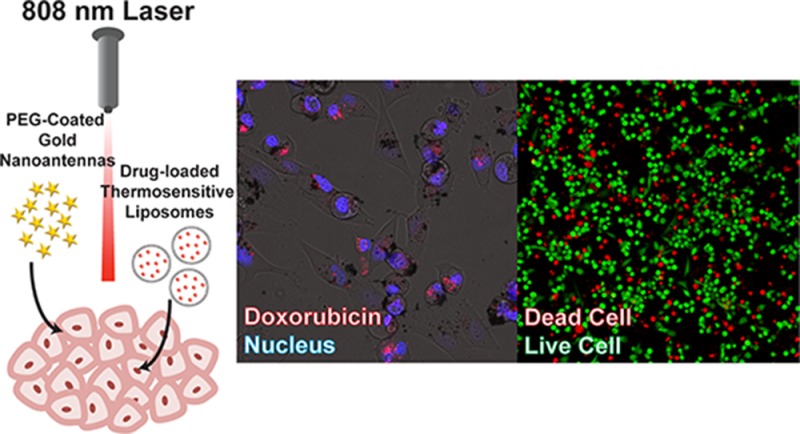- Record: found
- Abstract: found
- Article: not found
Gold Nanoantenna-Mediated Photothermal Drug Delivery from Thermosensitive Liposomes in Breast Cancer

Read this article at
Abstract

In this work, we demonstrate controlled drug delivery from low-temperature-sensitive liposomes (LTSLs) mediated by photothermal heating from multibranched gold nanoantennas (MGNs) in triple-negative breast cancer (TNBC) cells in vitro. The unique geometry of MGNs enables the generation of mild hyperthermia (∼42 °C) by converting near-infrared light to heat and effectively delivering doxorubicin (DOX) from the LTSLs in breast cancer cells. We confirmed the cellular uptake of MGNs by using both fluorescence confocal Z-stack imaging and transmission electron microscopy (TEM) imaging. We performed a cellular viability assay and live/dead cell fluorescence imaging of the combined therapeutic effects of MGNs with DOX-loaded LTSLs (DOX-LTSLs) and compared them with free DOX and DOX-loaded non-temperature-sensitive liposomes (DOX-NTSLs). Imaging of fluorescent live/dead cell indicators and MTT assay outcomes both demonstrated significant decreases in cellular viability when cells were treated with the combination therapy. Because of the high phase-transition temperature of NTSLs, no drug delivery was observed from the DOX-NTSLs. Notably, even at a low DOX concentration of 0.5 μg/mL, the combination treatment resulted in a higher (33%) cell death relative to free DOX (17% cell death). The results of our work demonstrate that the synergistic therapeutic effect of photothermal hyperthermia of MGNs with drug delivery from the LTSLs can successfully eradicate aggressive breast cancer cells with higher efficacy than free DOX by providing a controlled light-activated approach and minimizing off-target toxicity.
Related collections
Most cited references65
- Record: found
- Abstract: found
- Article: not found
Hyperthermia in combined treatment of cancer.
- Record: found
- Abstract: found
- Article: not found
Nanoparticle delivery of cancer drugs.
- Record: found
- Abstract: found
- Article: not found
